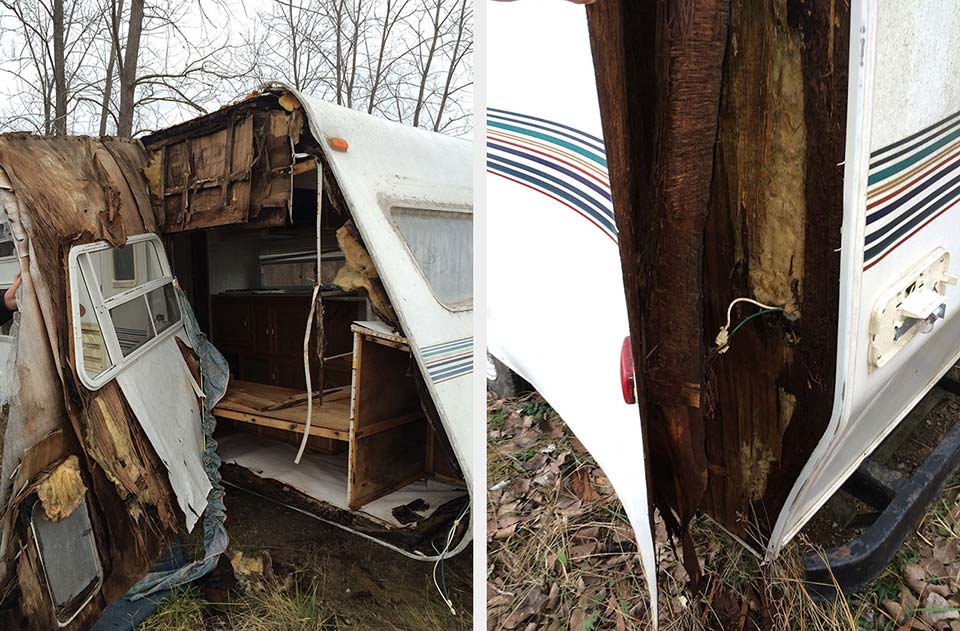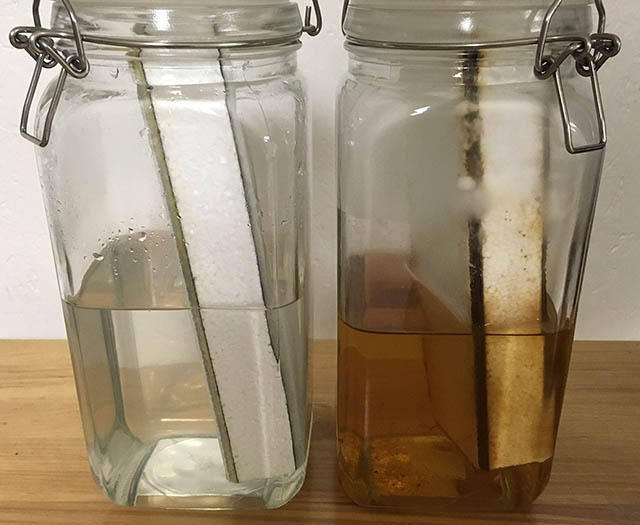
Water and Wood Don’t Mix
Take a look at what can happen to a traditional RV with wood construction when leaks occur.
Mold growth, rotting, warping and delamination are common, and this can cause thousands of dollars to repair.
What is Lauan?
The term lauan (or luan) comes from the lauan tree, native to the Philippines and other Southeast Asian countries. Sometimes referred to as Philippine Mahogany or Meranti, it is the general name given to a wide variety of related woods imported from the Philippine Islands, Malaysia and Indonesia. It is not an actual mahogany. Of all the hardwoods, Philippine lauan was once the most plentiful. This is a trade name for underlayment plywood. Aside from inconsistencies in species, density, dryness, quality of surface and edges, and the squareness of shape, the main problem is always present: it is wood, and wood soaks in water, grows mold, rots and warps — in turn, these problems help cause delamination.
Read on for more about delamination, but see our related pages about Mold and Mold Testing and Temperature and Humidity Resistance, which includes information about another delamination factor: Thermal Expansion (and the Coefficient of Linear Thermal Expansion, or CLTE).
What Does Delamination and Rot Look Like Inside the Wall of Your RV
Have you ever seen an RV with what appears to be air bubbles? That’s delamination – the wood is separating from the outer skin, and can no longer support the structure. Water seeping in has soaked the wood. This, along with freezing, thawing and hot temperatures causes it to decompose and loosen adhesive bonds. Because of the moisture or water presence, mold and mildew are formed or accelerated during this process.
What you don’t see can make all the difference – a difference in the support structure of your walls, the level of road noise, the comfort level inside your rig, the quality of air your family breathes, and the longevity of your RV.


Water Soak Test
In jars half filled with water we placed laminated RV sidewall cutouts, one made with Azdel composite and the other with lauan. We sealed the jars. Within six days there was visible mold growth, which falls right in the middle of the typical five-to-seven day range. This photo was taken at 51 days. The Azdel panel was 100% unaffected.
The lauan wood layers are fully soaked and the breaking down process is well underway. The panel is already experiencing the beginning of delamination, which would require repair, and this is without the added problem of cold and hot cycles, or worse, freezing and thawing.
Many RV’s sit through months of winter, subjected to freezing, thawing, heating and repeating the cycle with the potential for water seeping into the wall. We know what happens to water when it freezes. The expansion from frozen water speeds up and exacerbates the problem of delamination.
What can you do to protect your RV from delamination?
Regular maintenance performed on your roof seals, around windows, slide-outs and more help to prevent water from seeping in. There are plenty of blogs, RV forums and websites that will advise you on how to purchase a used RV while avoiding an existing issue. Purchasing an RV with AZDEL Onboard is your best bet in avoiding this issue and the costly repairs and other concerns that come with it.
Before you buy your next RV, learn about the construction. If you want an RV that will last, and provide you with the comfort and durability you, your family and your investment deserve, be sure it has AZDEL Onboard!